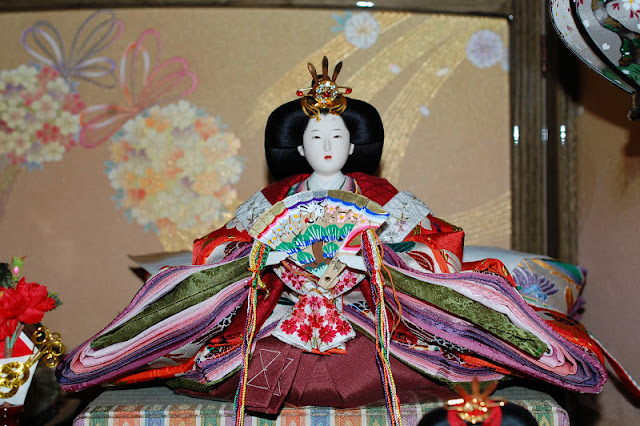Chances are, if you think of a Japanese doll, you are actually thinking of the specialized doll for the Hinamatsuri. These dolls show up on everything from Hello Kitty to free crackers given away by coffee shops.
 |
| As seen here |
The Japanese Hinamatsuri hina are often labeled as dolls, but these dolls are for not for playing with! Their delicate features give off an aura of priceless treasure (and they often are, with good sets reaching past five thousand dollars a set), and yet they are crafted for young girls, with grandparents often buying a set for their new granddaughter or passing a set down through the generations.
Dressed in clothing styled from the Heian Period (C.E. 794-1185), these dolls represent good fortune for girls—in fact, the Hinamatsuri set up is representing the marriage of the Lord and the Lady at the very top! The Hinamatsuri is so correlated with the idea of marriage that there is an old saying that if a girl does not take her Hinamatsuri display down on March 3rd, that she will marry late or not at all! Though I believe it's fallen out of fashion in these modern times.
The Hinamatsuri, often translated as “Girls’ Day” or “Doll Festival,” takes place on March 3. In Japan, 3 is considered an auspicious number, and 3/3 even more so.
During this festival, elaborate dolls depicting a wedding scene are placed on an elaborate display consisting of 7 shelves. Girls will often feed their dolls with special sweets and a sweet type of alcohol that they will pour into miniature dishes that the dolls hold.
This festival evolved from the Peach Festival (Monto no Sekku), the peach symbolizing feminine qualities, such as mildness, fertility, and obedience. The use of dolls evolved from protective talismans to more of a celebration display in the Edo Period (C.E. 1615-1868), more specifically in 1627 when the empress decided to start the trend. The court quickly latched on to the idea, and the merchants and peasantry after that. Within a hundred years, over six types of Hinamatsuri dolls boomed into production.
Today, the Hinamatsuri has become widely commercialized. It is celebrated with a basic set of 15 dolls, though some only use the main Lord and Lady, with various household furniture as accessories and a silk screen to place behind the Lord and Lady. A decent set will probably cost over $5,000.
From fertility festival to the elaborate doll festival Japanese girls celebrate today, the Hinamatsuri festival has changed due to commercialism and imperial favor and has created a new art form of dolls.
Well, Hinamatsuri is done and gone, but here are some of the pictures I took of Hina-chan's hina dolls when they were set up in early February.
 | |
| Top: Lord and Lady; Middle: Three Ladies of the Court; Bottom: The Five Musicians; Lowest: The Lady's Dowery |
 |
| One of the three Ladies of the Court |
 |
| Hinano (nicknamed 'Hina') in front of the hina ningyou (full title of the dolls) for the Hinamatsuri |
 |
| One of the three Ladies of the Court |
 |
| The Lady |
 |
| A musician missing his instrument |




No comments:
Post a Comment